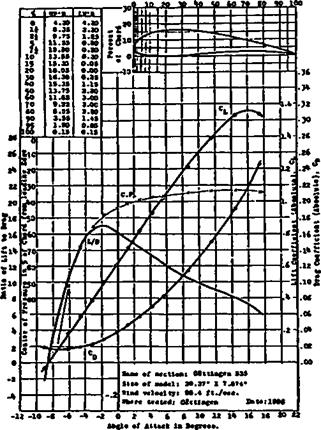OTHER WIND TUNNEL EXPERIMENTS
Apart from straightforward measurements of the three basic forces, lift, drag and pitching moment on a wing, wind tunnels allow many other kinds of investigation to be made. If the test model is fitted with suitable internal tubes and perforations, the pressure variation over the surfaces may be discovered. The diagrams of Figures 8.1, 8.2 and 8.3 were constructed in this way. Flow visualisation tests of the kind used by Pressnell (8.9) are widely done, with various types of liquid and, in recent times, liquid crystal material for the coating substance. Powder may be introduced into the flow through small holes in the
|
Fig. 10.5 A typical wind tunnel test result of 1925, as published in standard form by the N. A.C. A. Note that the centre of pressure is shown as lying at 120% (i. e. aft of the trailing edge) at a lift coefficient of 0.2, corresponding to a fairly fast flight speed, at minimum profile drag. The model size of 20cm x 1 metre gave an aspect ratio of 5. The Reynolds number at a flow velocity of 30m/s was approximately 410,000, the wind tunnel being at Gottingen University. |
model wing, to trace the boundary layer from any chosen point A very common and useful technique is to inject fine streamers of smoke into the test section upstream of the model. This reveals not only the general flow of the streamlines but where the smoke becomes trapped in the boundary layer the separation bubbles show up. The smoke is sometimes made by trickling oil down a hot, vertical wire, which has very little effect on general turbulence.
A simple stethoscope connected to a fine capillary probe may allow the experimenter, to listen to the boundary layer and this is one of the most sensitive methods of detecting the point of transition from laminar to turbulent flow. Where the flow is laminar, a faint hissing is heard. Turbulent flow emits a distinctive crackling. This device was used many years ago by August Raspet to detect separation on full-sized sailplane wings in flight, but it has proved useful in the wind tunnel many times since. To avoid disturbing the delicate flows being studied, the probe must be inserted always from the downstream side.












